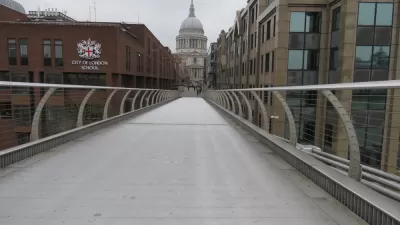A report from Imperial College London, viewed as the "gold standard" by British leaders, was instrumental in compelling the U.S. and the U.K. to enact stronger policies to contain COVID-19. But was it too late?

On March 16, U.K. Prime Minister Boris Johnson announced that the nation needed to take stronger actions to stem the spread of the novel coronavirus.
Last week we asked everyone to stay at home if you had one of two key symptoms: a high temperature or a new and continuous cough.
Today, we need to go further, because according to SAGE [the Scientific Advisory Group for Emergencies] it looks as though we’re now approaching the fast growth part of the upward curve.
And without drastic action, cases could double every 5 or 6 days.
"The low-key British response was driven by a controversial theory embraced by the U.K. government’s top scientists: that the best way to ease the long-term consequences of the coronavirus pandemic was to allow the virus to spread naturally in order to build up the population’s herd immunity," wrote Owen Matthews for Foreign Policy.
On Monday [March 16] night, that theory collided with the facts. A new analysis by immunologists at Imperial College London and the London School of Hygiene and Tropical Medicine of the impact of the coronavirus in Italy suggested that up to 30 percent of patients hospitalized with the virus would require intensive care treatment. Those numbers, if repeated in the U.K., would quickly overwhelm Britain’s state-run National Health Service.
Exactly one week later, the prime minister announced the nation was going into a "virtual lockdown." On Friday, it was reported that Johnson had become the world's first head-of-state to test positive for COVID-19, along with British Health Secretary Matt Hancock.
510,000 fatalities in the U.K; 2.2 million in the U.S.
Mark Landler and It wasn’t so much the numbers themselves, frightening though they were, as who reported them: Imperial College London."
The report warned that an uncontrolled spread of the disease could cause as many as 510,000 deaths in Britain. American officials said the report, which projected up to 2.2 million deaths in the United States from such a spread, also influenced the White House to strengthen its measures to isolate members of the public.
The report [pdf] outlines two fundamental strategies to contain the virus:
- Mitigation, which focuses on slowing but not necessarily stopping epidemic spread—reducing peak healthcare demand while protecting those most at risk of severe disease from infection.
- Suppression, which aims to reverse epidemic growth, reducing case numbers to low levels and maintaining that situation indefinitely. Each policy has major challenges.
"The U.K. government began with a policy of mitigation, aiming to protect the people most vulnerable to COVID-19: people over the age of 70 and people with underlying health conditions, including anyone who receives seasonal flu vaccines," writes Timothy Huzar for Medical News Today. "This initial policy did not involve significant restrictions on the movement of the general population."
[A] suppression strategy would result in significantly fewer deaths and less demand for critical care beds than a mitigation strategy.
In the authors’ words, this means that “A minimum policy for effective suppression is, therefore, population-wide social distancing, combined with home isolation of cases and school and university closure.”
Following China's example
“The U.K. has struggled in the past few weeks in thinking about how to handle this outbreak long term,” Dr. Ferguson said in an interview on Monday, just after the report was released, add Landler and Castle. “Based on our estimates and other teams’, there’s really no option but follow in China’s footsteps and suppress.”
How long?
For the 228 million Americans in at least 25 states, 74 counties, 14 cities, and one territory are being urged to stay home as of March 27, according to The New York Times, the paper advises they get used to social distancing.
"The suppression strategy would need to be in place until an effective vaccine is produced, and the authors predict that this will take at least 18 months," writes Huzar. "Social distancing would need to be in place for most of this time..."
Additional media reports on the Imperial College London analysis can be found in The Washington Post, CNN, and Reuters.
COVID-19 update, March 27: Total cases: 597,335, with the U.S. reporting the most, 104,686. Total Deaths: 27,365, led by Italy, Spain, and China.
Related in Planetizen:
- Britain Shuts Down and India Locks Down to Contain COVID-19, March 27, 2020
Hat tip to SDGreg.
FULL STORY: Behind the Virus Report That Jarred the U.S. and the U.K. to Action

Study: Maui’s Plan to Convert Vacation Rentals to Long-Term Housing Could Cause Nearly $1 Billion Economic Loss
The plan would reduce visitor accommodation by 25,% resulting in 1,900 jobs lost.

North Texas Transit Leaders Tout Benefits of TOD for Growing Region
At a summit focused on transit-oriented development, policymakers discussed how North Texas’ expanded light rail system can serve as a tool for economic growth.

Why Should We Subsidize Public Transportation?
Many public transit agencies face financial stress due to rising costs, declining fare revenue, and declining subsidies. Transit advocates must provide a strong business case for increasing public transit funding.

Alabama: Trump Terminates Settlements for Black Communities Harmed By Raw Sewage
Trump deemed the landmark civil rights agreement “illegal DEI and environmental justice policy.”

Dear Tesla Driver: “It’s not You, It’s Him.”
Amidst a booming bumper sticker industry, one writer offers solace to those asking, “Does this car make me look fascist?”

A Visual Celebration of Manhattan’s Chinatown Elder Community, Through Food
Lanterns, cafeteria trays, and community connection take center stage in this stunning photo essay.
Urban Design for Planners 1: Software Tools
This six-course series explores essential urban design concepts using open source software and equips planners with the tools they need to participate fully in the urban design process.
Planning for Universal Design
Learn the tools for implementing Universal Design in planning regulations.
City of Santa Clarita
Ascent Environmental
Institute for Housing and Urban Development Studies (IHS)
City of Grandview
Harvard GSD Executive Education
Toledo-Lucas County Plan Commissions
Salt Lake City
NYU Wagner Graduate School of Public Service





























